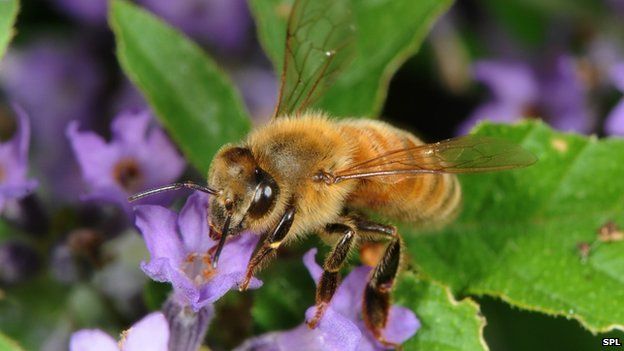Bee-friendly plants put to the test
- Published

Researchers have used an experimental garden to put pollinator-friendly plants to the test.
The University of Sussex scientists counted the number of insects visiting the plants in their garden.
They say their findings show that insect-friendly plants are just as pretty, cheap and easy to grow as less pollinator-friendly varieties.
Their results are published in the Journal of Functional Ecology.
PhD student Mihail Garbuzov used 32 different varieties of popular garden plants. These included some nectar-rich and highly scented plants he thought would be attractive to insects and some that seemed to be less attractive.
Researcher Mihail Garbuzov says the most pollinator-friendly plants attract 100 times more insects than the least
While the small-scale study did not produce an exhaustive list of the best plants for pollinating insects, the team says the data has put a number on just how many more pollinators the right plants can attract.
Mr Garbuzov told the BBC: "Some of the best plants attracted approximately 100 times as many insects as the worst.
"And the plants that are attractive to insects are not more expensive, and they're just as pretty."
The researchers wrote in their paper that there was "great scope for making gardens and parks more insect friendly" by selecting the right plants.
Tips for insect-friendly gardening are already available from a variety of sources, but the researchers say they are largely based on "opinion and general experience".
The aim of this study, said Prof Francis Ratnieks, from the University of Sussex, was to "put that advice on a firmer scientific footing, by gathering information about the actual number of insects visiting the flowers to collect nectar or pollen".
Counting bees
The researchers gathered their data simply by visiting each of the patches of flowers every day over two summers and counting the number of insects on the flowers.
Their results did lead them to make some horticultural recommendations - they found that borage, lavender, marjoram and open-flower dahlias varieties were very good for insects.
The colourfully named bowles mauve everlasting wallflower was also very attractive to pollinators, while the least attractive flowering plant for insects was the very popular geranium.
Marjoram, the researchers say, was probably the best "all-rounder", attracting honey bees, bumble bees, other bees, hover flies, and butterflies.
Borage was the best for honey bees and lavender and open-flowered dahlias were most attractive to bumblebees.
The team put a number of varieties of lavender to the test and found that highly bred hybrids, including some with novel colours - such as white or pink - that have been carefully bred into the plants proved the most attractive to insects.
Dr Nigel Raine, from Royal Holloway University of London, commented that with bee populations declining across the world, "we can all give bees a helping hand by planting the right flowers to give them the nectar and pollen they need".
"This study highlights that it's important for bee-friendly gardeners to choose what you plant with care," he added.
"Gardeners and town planners should think carefully about the mixture of flowers they plant to ensure food is available for a wide range of bees and other important insect pollinators.
"It's also important to cater for the needs of the rarer species and provide food at times when there might be fewer wild flowers in bloom."
This miniature taste test, known as the proboscis extension reflex test, can be used to work out if bees are able to detect the scent of a flower
- Published3 October 2013
- Published18 July 2013
- Published18 May 2012